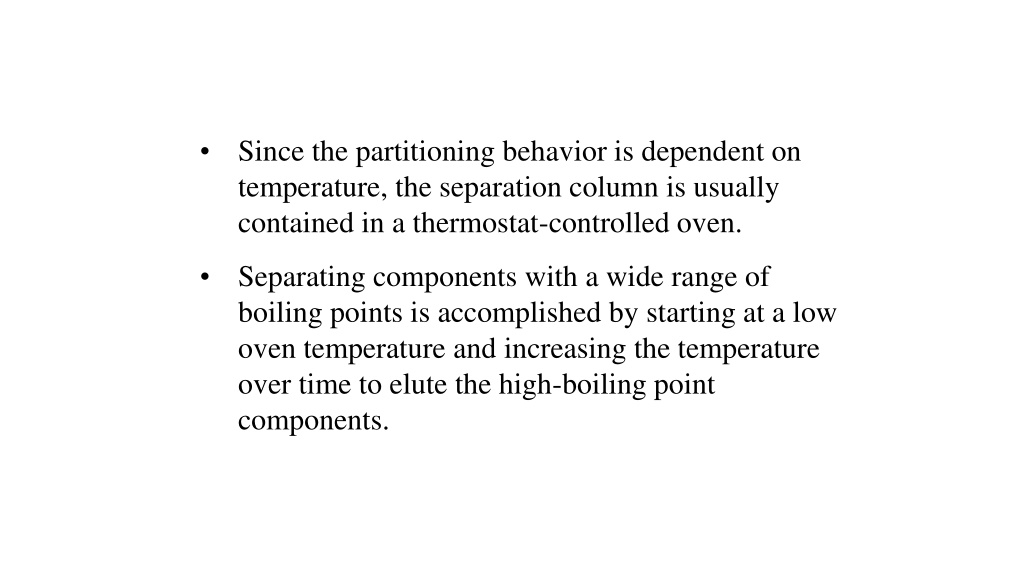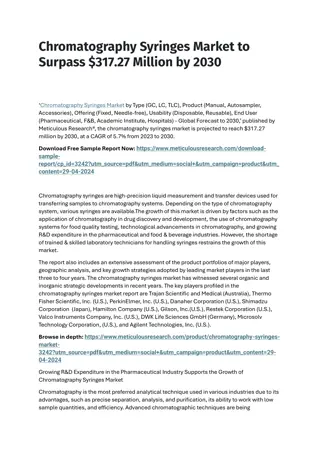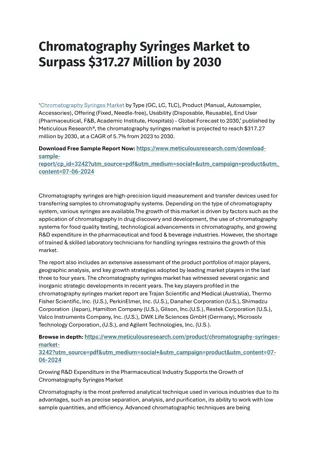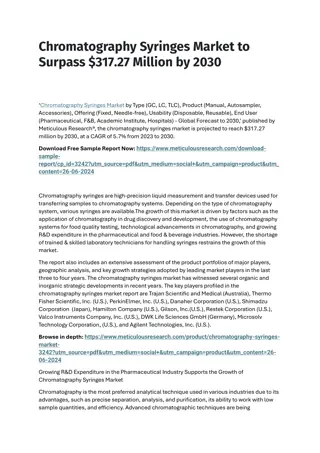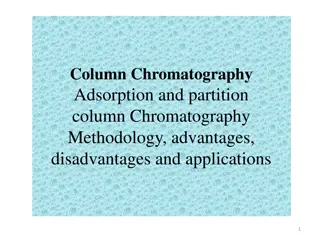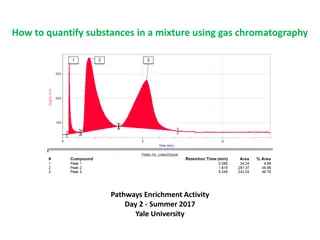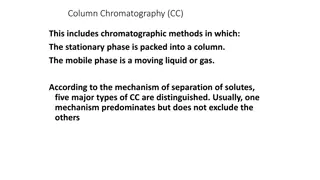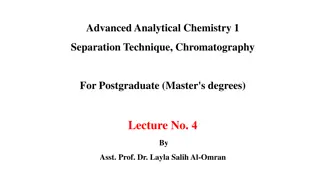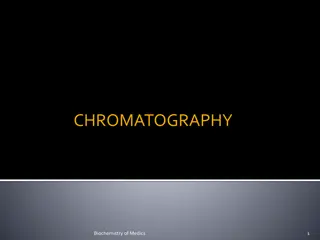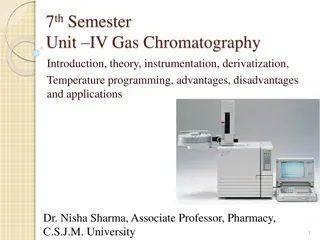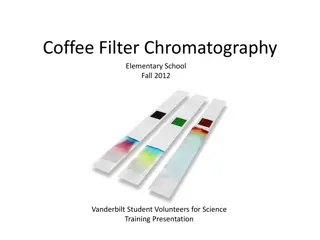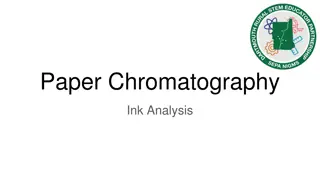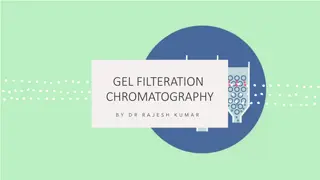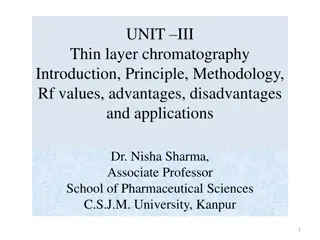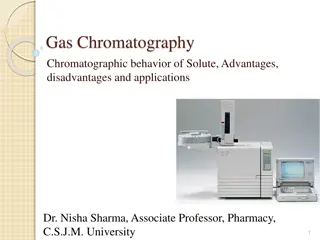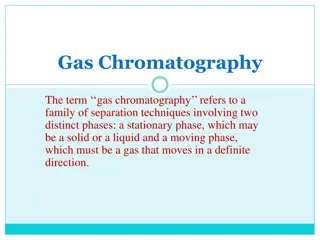Understanding Gas Chromatography Techniques and Applications
Gas chromatography is a powerful analytical technique used for separating and analyzing volatile compounds in various industries such as food analysis and drug identification. The process involves a separation column contained in a thermostat-controlled oven, along with a carrier gas system and detectors for accurate analysis. By controlling temperatures and elution times, GC provides precise separation of components with different boiling points, making it an essential tool for research and quality control.
- Gas Chromatography
- Analytical Technique
- Food Analysis
- Drug Identification
- Thermostat-Controlled Oven
Download Presentation

Please find below an Image/Link to download the presentation.
The content on the website is provided AS IS for your information and personal use only. It may not be sold, licensed, or shared on other websites without obtaining consent from the author. Download presentation by click this link. If you encounter any issues during the download, it is possible that the publisher has removed the file from their server.
E N D
Presentation Transcript
Since the partitioning behavior is dependent on temperature, the separation column is usually contained in a thermostat-controlled oven. Separating components with a wide range of boiling points is accomplished by starting at a low oven temperature and increasing the temperature over time to elute the high-boiling point components.
http://upload.wikimedia.org/wikipedia/commons/thumb/7/74/GC_Oven_inside.jpg/300px-GC_Oven_inside.jpghttp://upload.wikimedia.org/wikipedia/commons/thumb/7/74/GC_Oven_inside.jpg/300px-GC_Oven_inside.jpg A gas chromatography oven, open to show a capillary column
Pressure regulator Flow controller Gas Supply Gas Supply Gas supply The mobile phase (carrier gas) should be chemically inert, dry, and free from O2 (helium, argon, nitrogen and hydrogen). The carrier gas should be of high purity; impurities in the carrier gas such as water vapour, air and trace gaseous hydrocarbons can cause reactions with sample and cause column deterioration and affect detector performance. The gas supply is associated with pressure regulator and flow controller.
Flow meter Flow controller Septum Detector GC chart Injector Pressure regulator Recorder Sample Injection System Sample Injection System Oven Column Gas supply Preparation of the Sample Preparation of the Sample : : Samples GC must be volatile. Samples which are non volatile are converted into a volatile derivative. GC Column GC Column Most GC columns are made from high-purity fused silica capillary, the inner wall of the capillary coated with the stationary phase. GC columns vary in length from less than 2 m to 50 m or more. In order to fit into the column oven, they are usually formed as coils. The control of column s temperature is critical to attain a good separation in GC, thus the column is located inside a thermostated oven to control the temperature.
GC Detectors GC Detectors Thermal conductivity detector (TCD) Flame ionization detector (FID) Nitrogen phosphorous detectors (NPD)
GC Applications GC Applications: : Food Analysis Analysis of foods is concerned with confirming the presence and determination the quantities of the analytes (lipids, proteins, carbohydrates, preservatives, flavors, colorants, and also vitamins, steroids, and pesticide residues). Drug Analysis GC is widely applied to identification of the active components, possible impurities as well as the metabolites.
Environmental Analysis The environmental contaminants; e.g. (DDT) is present in the environment at very low concentrations and are found among many of other compounds. GC, with its high sensitivity and high separating power, is mostly used in the analysis of environmental samples. Forensic Analysis In forensic cases, very little sample is available, and the concentration of the sample components may be very low. GC is a useful due to its high sensitivity and separation efficiency.
Comparison of HPLC and GC Sample Volatility Sample Polarity HPLC No volatility requirement HPLC Separates both polar and non polar compounds Sample must be soluble in mobile phase GC Samples are nonpolar and polar GC Sample must be volatile
Comparison of HPLC and GC Sample Preparation Sample Size HPLC Sample must be filtered HPLC Sample size based upon column. Sample should be in same solvent as mobile phase GC GC Typically 1 - 5 L Solvent must be volatile and generally lower boiling than analytes
Comparison of HPLC and GC Separation Mechanism Detectors HPLC Both stationary phase and mobile phase take part HPLC Most common UV-Vis Wide range of non- destructive detectors 3-dimensional detectors GC GC Most common FID, universal to organic compounds Mobile phase is a sample carrier only
